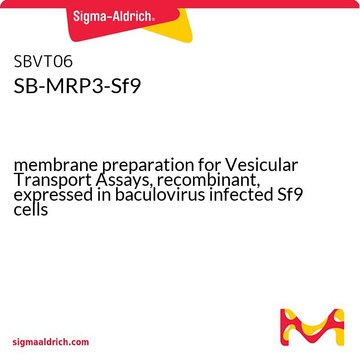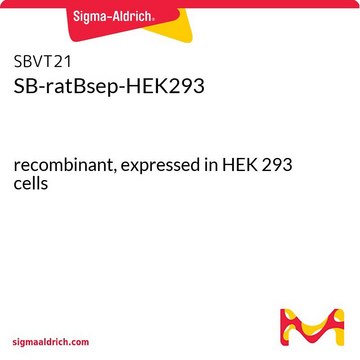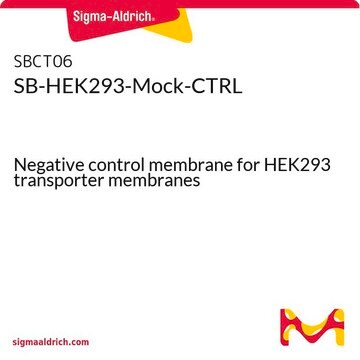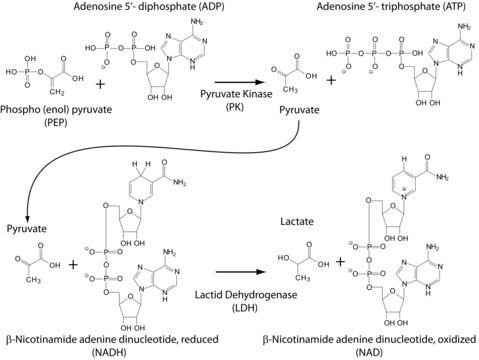추천 제품
재조합
expressed in Baculovirus infected High-5 cells
양식
liquid
농도
5 mg/mL
색상
off-white
UniProt 수납 번호
배송 상태
dry ice
저장 온도
−70°C
유전자 정보
human ... ABCB11(8647)
일반 설명
Membrane Preparations for Vesicular Transport Assays (VT) are suitable for general drug-efflux transporter interaction studies. Both substrate and inhibitor interactions can be assessed using vesicles. The success of substrate interaction studies strongly depends on the passive permeability of the compound. High permeability substrates might not be detected. Control Membranes with no-, or significantly lower transporter activity are also available.
애플리케이션
In the vesicular transport assay so-called "inside-out" membrane vesicles containing ABC transporters are applied. Incubating substrates of the respective efflux transporter in the presence of the inverted membrane vesicles and ATP will allow measuring accumulation of the substrates into the vesicles. In many cases radiolabeled reporter substrates are used but recently SOLVO developed the new PREDIVEZTM Vesicular Transport Kits that use fluorescent reporter substrates.
The standard vesicular transport assay is an inhibitory assay performed with cold test articles. This assay provides information on any interaction between the ABC transporter and the test article. The transport of the reporter substrate is measured in the presence of the test article (typically in 7 concentrations) and IC50 is defined as the concentration inhibiting the transport of the reporter substrate by 50%.
Should radiolabeled form of the investigated compound or adequate analytical methods (LC/MS, HPLC) be available, the vesicular transport assay may be performed in a direct format without the reporter substrate and may identify substrate nature of the test article. The vesicular transport substrate assay is a low throughput assay. It is suitable for low permeability test compounds as high permeability compounds may escape from the vesicles through the lipid bilayer.
The standard vesicular transport assay is an inhibitory assay performed with cold test articles. This assay provides information on any interaction between the ABC transporter and the test article. The transport of the reporter substrate is measured in the presence of the test article (typically in 7 concentrations) and IC50 is defined as the concentration inhibiting the transport of the reporter substrate by 50%.
Should radiolabeled form of the investigated compound or adequate analytical methods (LC/MS, HPLC) be available, the vesicular transport assay may be performed in a direct format without the reporter substrate and may identify substrate nature of the test article. The vesicular transport substrate assay is a low throughput assay. It is suitable for low permeability test compounds as high permeability compounds may escape from the vesicles through the lipid bilayer.
물리적 형태
Supplied as frozen membrane vesicles, containing 5 mg/ml membrane protein, labeled with volume, catalog number (transporter) and date of production.
법적 정보
Distributed for SOLVO Biotechnology, Inc.
관련 제품
제품 번호
설명
가격
Storage Class Code
10 - Combustible liquids
WGK
WGK 1
Flash Point (°F)
Not applicable
Flash Point (°C)
Not applicable
가장 최신 버전 중 하나를 선택하세요:
Kari T Kivistö et al.
Pharmaceutical research, 24(2), 239-247 (2006-12-21)
The role of drug transporters in pravastatin disposition is underlined by the fact that pravastatin does not undergo significant cytochrome P-450 (CYP)-mediated biotransformation. The organic anion transporting polypeptide 1B1 (OATP1B1), encoded by SLCO1B1, and multidrug resistance-associated protein 2 [MRP2 (ABCC2)]
Jasminder Sahi et al.
Chemico-biological interactions, 159(2), 156-168 (2005-12-17)
CI-1034, an endothelin-A receptor antagonist was being developed for pulmonary hypertension. Drug-drug interaction studies using human hepatic microsomes were conducted to assess CYP1A2, CYP2C9, CYP2C19, CYP3A4 and CYP2D6 inhibition potential; CYP3A4 induction potential was evaluated using primary human hepatocytes. CI-1034
Emese Kis et al.
Toxicology in vitro : an international journal published in association with BIBRA, 26(8), 1294-1299 (2011-11-29)
Bile salt export pump (BSEP, ABC11) is a membrane protein that is localized in the cholesterol-rich canalicular membrane of hepatocytes. Its function is to eliminate unconjugated and conjugated bile acids/salts from hepatocyte into the bile. In humans there is no
A Kosters et al.
Xenobiotica; the fate of foreign compounds in biological systems, 38(7-8), 1043-1071 (2008-08-01)
In recent years the discovery of a number of major transporter proteins expressed in the liver and intestine specifically involved in bile acid transport has led to improved understanding of bile acid homeostasis and the enterohepatic circulation. Sodium (Na(+))-dependent bile
Richard H Ho et al.
Pharmacogenetics and genomics, 20(1), 45-57 (2009-12-17)
Our aims were to identify and functionally characterize coding region nonsynonymous single nucleotide polymorphisms in the hepatic efflux transporter, bile salt export pump (BSEP; ABCB11), and to assess interindividual variability in BSEP expression. We identified 24 single nucleotide polymorphisms, including
자사의 과학자팀은 생명 과학, 재료 과학, 화학 합성, 크로마토그래피, 분석 및 기타 많은 영역을 포함한 모든 과학 분야에 경험이 있습니다..
고객지원팀으로 연락바랍니다.








